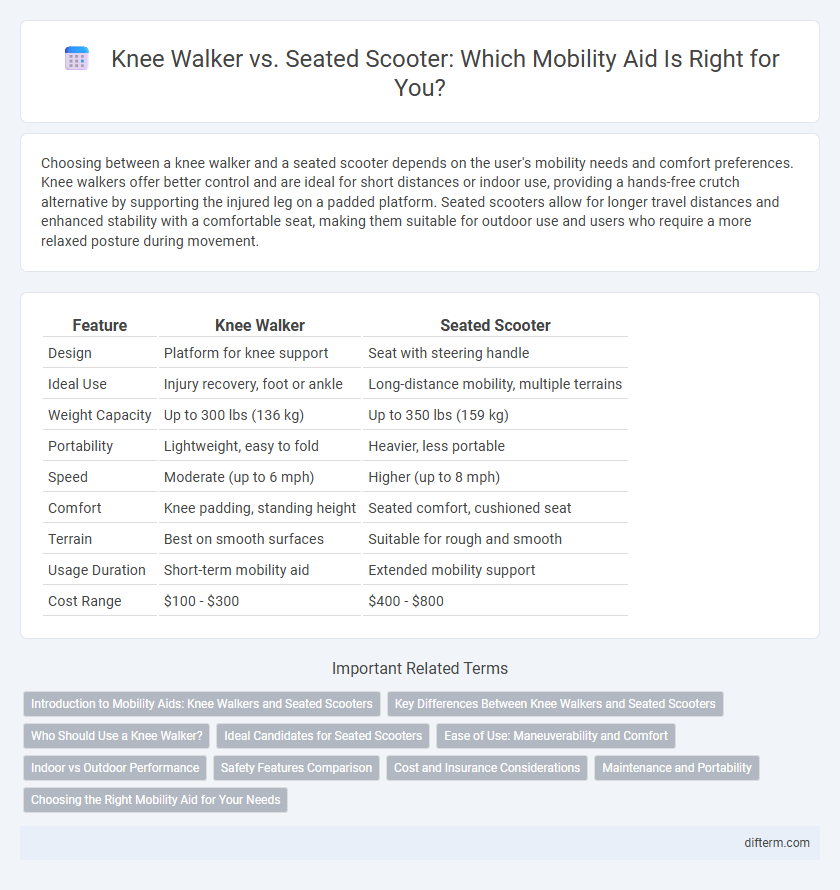Choosing between a knee walker and a seated scooter depends on the user's mobility needs and comfort preferences. Knee walkers offer better control and are ideal for short distances or indoor use, providing a hands-free crutch alternative by supporting the injured leg on a padded platform. Seated scooters allow for longer travel distances and enhanced stability with a comfortable seat, making them suitable for outdoor use and users who require a more relaxed posture during movement.
Table of Comparison
| Feature | Knee Walker | Seated Scooter |
|---|---|---|
| Design | Platform for knee support | Seat with steering handle |
| Ideal Use | Injury recovery, foot or ankle | Long-distance mobility, multiple terrains |
| Weight Capacity | Up to 300 lbs (136 kg) | Up to 350 lbs (159 kg) |
| Portability | Lightweight, easy to fold | Heavier, less portable |
| Speed | Moderate (up to 6 mph) | Higher (up to 8 mph) |
| Comfort | Knee padding, standing height | Seated comfort, cushioned seat |
| Terrain | Best on smooth surfaces | Suitable for rough and smooth |
| Usage Duration | Short-term mobility aid | Extended mobility support |
| Cost Range | $100 - $300 | $400 - $800 |
Introduction to Mobility Aids: Knee Walkers and Seated Scooters
Knee walkers and seated scooters serve as essential mobility aids designed for individuals with lower leg injuries or mobility impairments. Knee walkers offer support by allowing users to rest their injured leg on a padded platform while propelling with the uninjured leg, promoting stability and pain-free movement. Seated scooters provide a comfortable, seated option with four wheels and handlebars, ideal for longer distances and users needing more support and balance.
Key Differences Between Knee Walkers and Seated Scooters
Knee walkers provide support by allowing users to rest their injured knee on a padded platform, promoting better maneuverability and stability for short distances. Seated scooters offer a comfortable sitting position with handlebars for steering, designed for longer durations and less strain on the upper body. The primary differences lie in usage posture, control mechanisms, and suitability for varying mobility needs and terrain types.
Who Should Use a Knee Walker?
Individuals recovering from below-the-knee injuries or surgeries benefit most from knee walkers, especially those who need to keep weight off the foot or ankle while maintaining mobility. Knee walkers provide better stability and support for users with limited balance or lower body strength compared to seated scooters. They are ideal for patients requiring hands-free operation and improved maneuverability on uneven surfaces.
Ideal Candidates for Seated Scooters
Ideal candidates for seated scooters include individuals with limited upper body strength or balance issues, as these devices provide stable, full-body support and steering capability. People recovering from lower leg injuries who require extended periods of mobility with minimal weight-bearing on the affected limb benefit significantly from seated scooters. Seniors and those with mobility impairments that restrict walking endurance are also well-suited, as seated scooters offer comfortable, all-day use with enhanced safety and maneuverability on various surfaces.
Ease of Use: Maneuverability and Comfort
Knee walkers offer superior maneuverability with intuitive steering suitable for narrow indoor spaces, while seated scooters provide enhanced comfort through cushioned seating and higher weight capacity ideal for longer distances. Knee walkers require users to balance on one knee, which may limit comfort during extended use, whereas seated scooters allow full weight support and a more relaxed posture. Both devices prioritize ease of use but cater to different mobility needs based on user strength and typical terrain.
Indoor vs Outdoor Performance
Knee walkers provide superior maneuverability and stability on indoor surfaces, making them ideal for navigating tight spaces and smooth floors, while seated scooters excel in outdoor performance due to their larger wheels and enhanced suspension that handle uneven terrain effectively. Indoor use favors knee walkers for precise control and ease of turning, whereas seated scooters offer better comfort and durability during longer outdoor excursions. Choosing between the two depends on terrain type, with knee walkers optimized for flat, hard surfaces and seated scooters designed for varied outdoor environments.
Safety Features Comparison
Knee walkers typically feature sturdy frames, non-slip foot platforms, and handlebars with ergonomic grips, enhancing user stability and control while reducing fall risk. Seated scooters incorporate padded seats, adjustable speeds, and robust braking systems for secure maneuvering, especially on uneven terrain. Both mobility aids prioritize safety through enhanced shock absorption and reliable steering mechanisms tailored to different user needs.
Cost and Insurance Considerations
Knee walkers typically cost between $100 and $300, with some models covered by insurance under durable medical equipment benefits, reducing out-of-pocket expenses. Seated scooters, which range from $500 to $2,500, have less frequent insurance coverage and often require higher upfront payments or rental agreements. Evaluating insurance policies and potential reimbursements enhances affordability when selecting between knee walkers and seated scooters for mobility assistance.
Maintenance and Portability
Knee walkers typically require minimal maintenance with occasional tire inflation and brake checks, offering compact foldable designs for easy portability and storage. Seated scooters demand more regular maintenance including battery care, tire replacement, and motor checks, but provide enhanced mobility over diverse terrains. Both devices prioritize portability, yet knee walkers are lighter and more manageable for frequent transport.
Choosing the Right Mobility Aid for Your Needs
Selecting the right mobility aid depends on factors such as comfort, range of motion, and terrain adaptability. Knee walkers provide better support for individuals with lower leg injuries, offering stability and ease of maneuvering on various surfaces. Seated scooters excel in long-distance travel and outdoor use with enhanced speed and passenger seating, making them ideal for those requiring prolonged mobility assistance.
Knee walker vs Seated scooter Infographic

 difterm.com
difterm.com